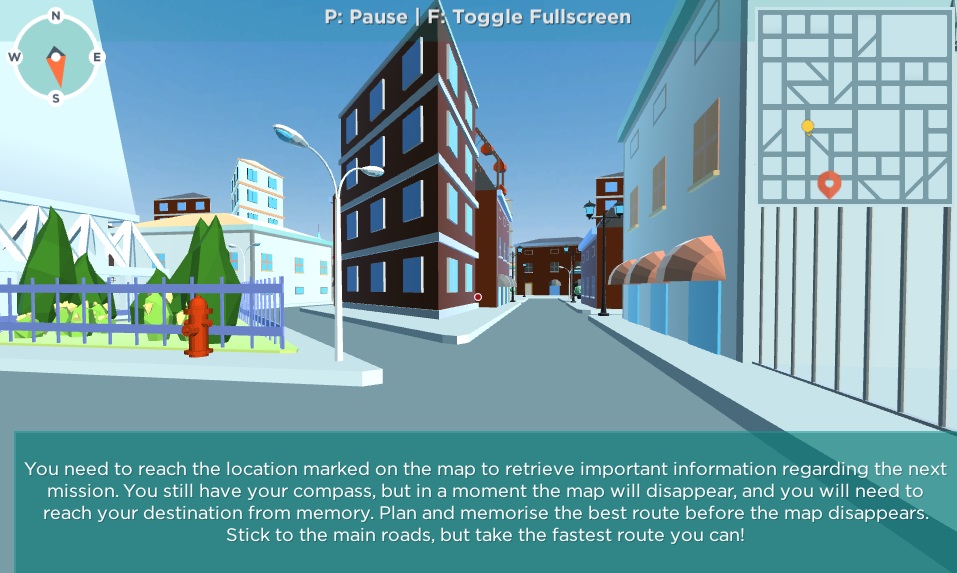Description
Example images from Map Reading missions are shown below. A written description of a mission now follows.
There were 5 Map Reading No Memory and 5 Map Reading With Memory tests ('missions') in the Navigation battery. While there were a few differences between Map Reading No Memory and Map Reading With Memory missions, they were broadly similar and followed the same pattern of activity. Each mission comprised a single task. In every task (and hence mission), twins were allowed up to 2 attempts to succeed in responding correctly. If the first attempt was successful, the task ended; if not, the task would begin again with the second attempt.
In each mission, twins were asked to make their way from the starting point to the target, as marked on a map on screen. The stimulus map, which appeared at the start of each attempt of each mission, showed the starting point as a yellow dot and the target as a larger orange/red icon. The yellow dot had a small pointer on one side, representing the current direction of view of the twin within the virtual world; changing the direction of view (by moving the mouse to left or right) would rotate the pointer on the map in the corresponding direction.
The stimulus remained on screen for a fixed period of time at the start of the attempt. During the stimulus, while it was possible to rotate the direction of view, it was impossible for the twin to move at street level within the virtual world; this was designed to encourage twins to absorb the instructions and analyse and remember a quick route to the target. Towards the end of the stimulus period, either the yellow dot (Map Reading No Memory) or the entire map (Map Reading With Memory) would start to flash, as a warning that it would soon disappear. Then at the end of the stimulus period the stimulus would be removed from the screen: in Map Reading No Memory, the yellow dot disappeared leaving the map and the target icon displayed; in Map Reading With Memory, the entire map disappeared. From the moment of the removal of the stimulus, twins were able to start to move around in search of the target.
Each Map Reading attempt had a time limit of either 60 seconds (Map Reading No Memory) or 120 seconds (Map Reading With Memory). The maximum time that could be spent on the mission was therefore the sum of the two attempt time limits (120 seconds for Map Reading No Memory, 240 seconds for Map Reading With Memory), if both attempts were used. There was no progress bar or timer on screen to help twins keep track of time; however, "hurry up" prompts appeared on screen as the time limit approached in each attempt. If the time limit expired without the target being reached, then the attempt would simply end and the next attempt (or the next mission) would begin.
Feedback was provided at each stage in order to keep a twin moving towards the goal of completing the mission. There were normally three possible outcomes for each task: it could be completed successfully without any errors, in other words by the best possible route; it could be completed successfully but with some error, by a less efficient route; or it was failed (by timing out). As mentioned above, an approaching timeout was signalled by 'hurry up' messages flashing on the screen; and ultimate failure was implied by the task ending without success. Successful completion of the task (with or without an error) was explicitly shown in more than one way: as the target was approached, it appeared on screen in the form of a group of sparkling dots; and when the target was reached, success was signalled using text on screen.
To help twins in following their chosen route (with or without the map), the compass image remained on screen throughout all attempts of all missions.
In order to respond in this type of mission, movement in the virtual world was achieved by holding down the mouse button to move forwards, and by moving the mouse to left or right in order to turn. If a twin did not make any input during the time limit of the attempt (no mouse-down events), then the attempt would time out without any meaningful response data being recorded. If the entire mission (comprising 2 attempts) passed without any input at all, then the game would be 'auto-paused' after the second attempt, to prevent a sequence of missions from proceeding unattended and without input. After auto-pausing, a message would appear on screen, requiring the twin to click on a button in order to proceed to the next mission in the battery.
As in all other Navigation missions, twins could pause at any stage by pressing P on the keyboard; this would stop the clock and blank out the image of the streets. A further click on P would then resume the mission.
Because of the nature of Map Reading missions, it is not possible to reproduce the items (mission attempts) in full detail. However, the initial stimulus for each mission (which was identical for both attempts) is reproduced below in the Table of Test Items, and example images from missions are shown under the next heading.
Example Images
The images below are screen shots taken from Map Reading missions. These images serve as examples of how missions were carried out and completed. Each mission started with instructions in the form of text and a stimulus map image showing the current location and the target location. The first image, below, shows the introductory screen from Map Reading No Memory mission 1:
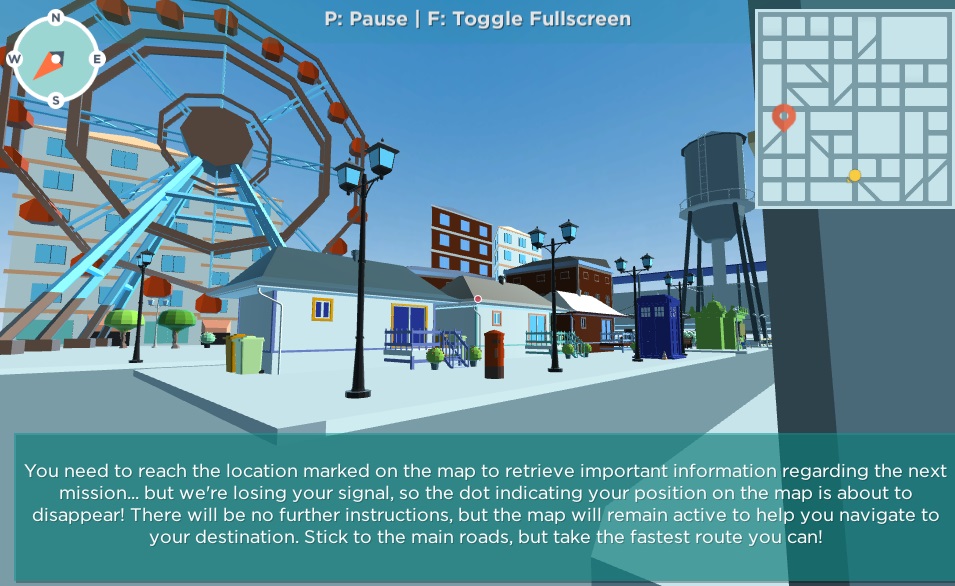
The crucial stimulus is the map top-right. This shows the current location (yellow dot) as well as the target location (orange/red icon). The text instruction describes the aim in broad terms ('You need to reach the location marked on the map...'), with a reminder that 'the dot indicating your position on the map is about to disappear' but that 'the map will remain active'. The instruction ends with the prompt to 'take the fastest route you can', because a higher score will be gained by following the most direct route.
The next image (below) is the similar introductory screen from Map Reading With Memory mission 1. This has very similar features to the image above. The crucial difference is in the text instructions that 'in a moment the map will disappear, and you will need to reach your destination from memory' and to 'Plan and memorise the best route before the map disappears'.
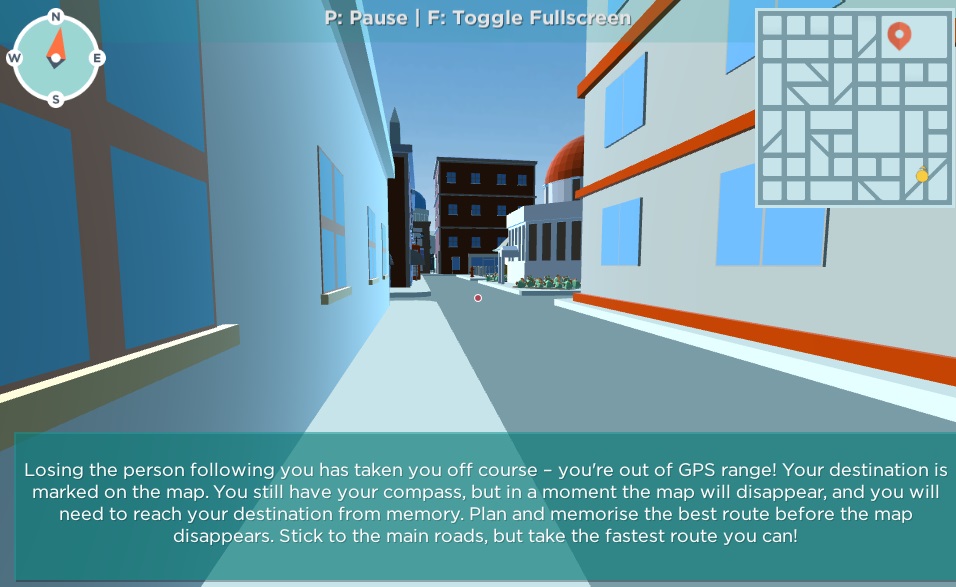
The next image (below) shows the appearance of the target at the end of a Map Reading No Memory mission. From a distance, the target appears initially as a group of sparkling dots. As the target is approached nearer, a rotating yellow folder becomes visible. In order to complete the task, and hence the mission, the twin had to keep moving until the target was reached. Note that, as in all Map Reading No Memory missions, the map has remained on screen with the red/orange target icon showing the destination, but without the yellow dot indicating current location; the instruction text has now disappeared; and the compass has remained on screen throughout.
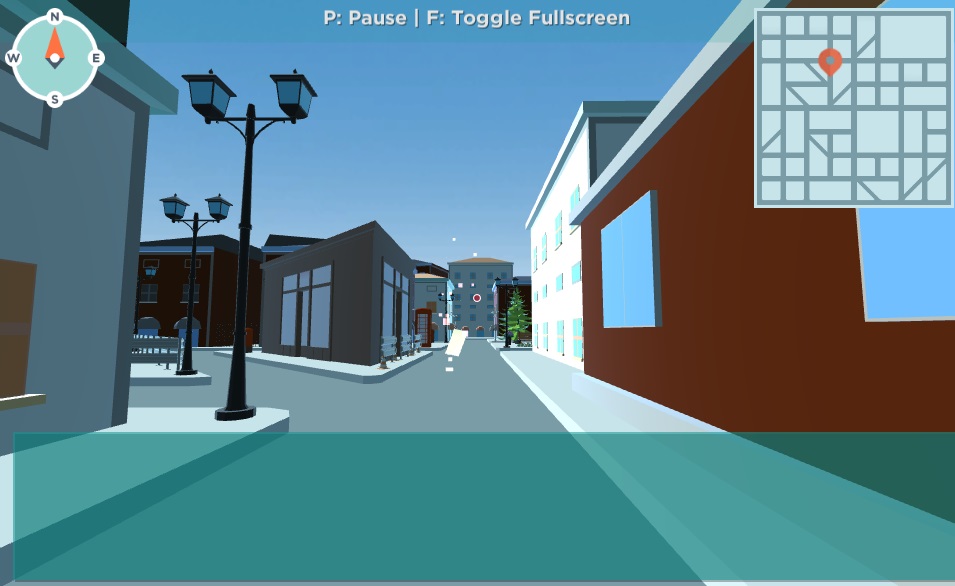
The next image (below) gives an example of the feedback from successful completion of a mission (in this case, Map Reading With Memory). The target (represented by a rotating folder surrounded by sparkling dots) remained briefly on screen while the feedback text was presented (indicating success and the imminent start of the next mission). Note that, as in all Map Reading With Memory missions, the map has been removed from the screen; and the compass has remained on screen throughout.
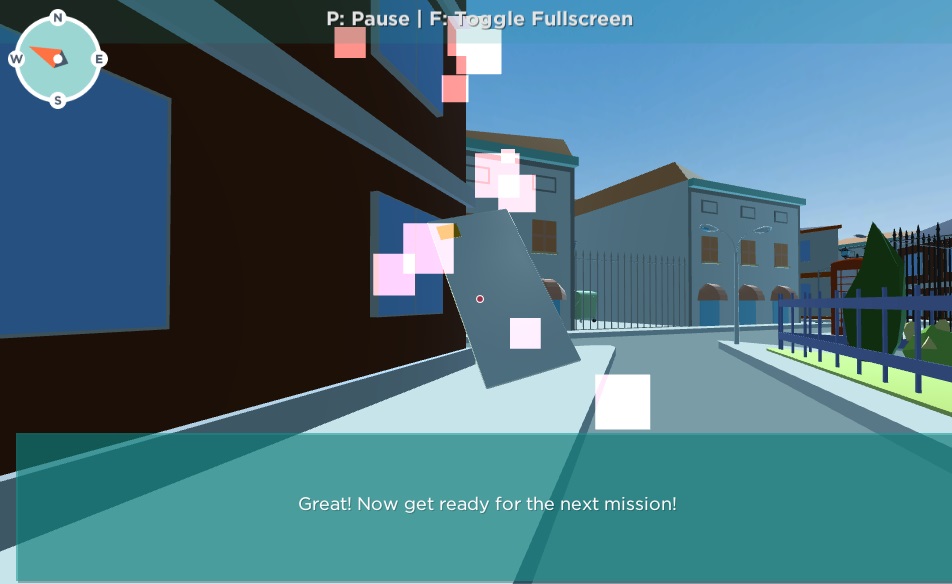
The final image, below, illustrates the 'hurry up' prompt that appears as the attempt time limit approached. (This example is from a Map Reading No Memory mission, hence the time limit was 60 seconds and the map has remained on screen.) The prompt repeatedly flashed on screen. If the attempt was not completed within the time limit, then the attempt simply ends without further feedback; if it was the first attempt, then the second attempt would then start with the same stimulus as before; if it was the second attempt, then the next mission would begin.
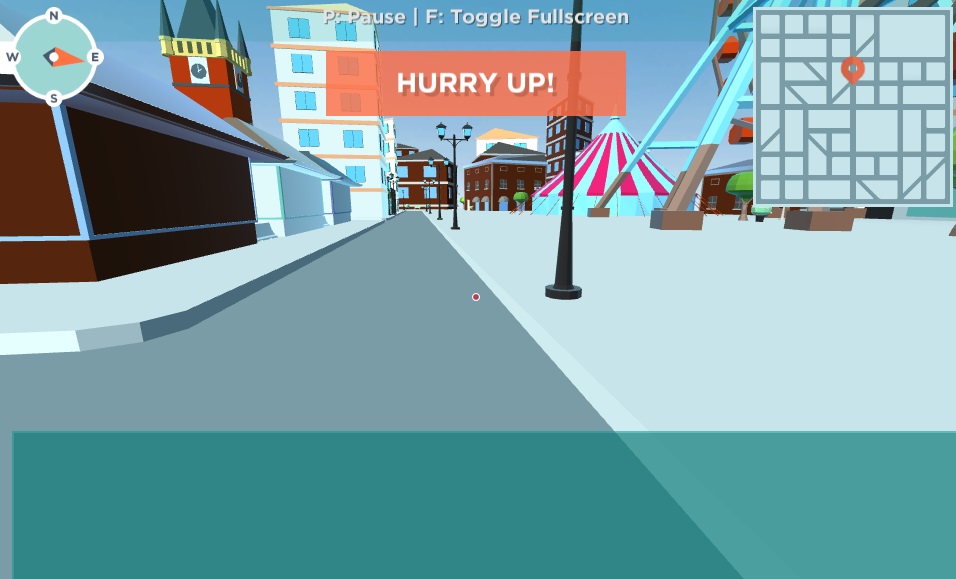
Web Test Rules
The Map Reading missions followed these rules:
- Tasks
Each mission comprised a single compulsory task. - Attempts
Up to 2 attempts were allowed to complete each mission (and hence each task). Each mission ended either on successful completion or after 2 failed attempts. - Timeout rule
A timeout applied to each attempt:- 60 seconds for every Map Reading No Memory attempt
- 120 seconds for every Map Reading With Memory attempt
- Widgets
The compass remained on screen for the entire duration of every attempt of every mission. The map, showing the current position and the position of the target, appeared on screen during the initial stimulus. After the stimulus:- The map remained on screen, but without showing the current position, for every Map Reading No Memory attempt
- The map disappeared completely for every Map Reading With Memory attempt
- Pausing
The mission could be paused at any time by pressing P on the keyboard. The image of the virtual world was then replaced on screen by text explaining that the mission was paused, and that pressing P again would resume. Each mission could be paused indefinitely in this way, as often as a twin wished. - Auto-pausing
If a twin left a mission unattended for its entire duration, no input would be recorded and it would eventually time out. In these circumstances, in order to prevent a sequence of missions from timing out without input, an "auto-pause" would come into effect: the entire game was paused at the end of the mission, and the image of the virtual world on screen was replaced by explanatory text. A twin could then resume (at the start of the next mission) by clicking on a button. A Map Reading mission left unattended in this way was effectively forfeited, and was not presented again. - Attempt outcomes
The possible outcomes for each attempt were as follows:- Success without error: target reached by best possible route
- Success with error: target reached by a less efficient route
- Failure due to timeout
- Second attempt skipped due to success in first attempt
- Timeout with no input in the attempt (could occur in each attempt independently or across both attempts in the entire mission)
Dataset Item Variables
The item variables relating to each Map Reading mission, as listed in the table below, were generated automatically by programs on the web server. For the sake of completeness, the table also lists derived variables relating directly to an Map Reading mission or its component attempts. Note that the dataset only includes data for completed missions. If a twin started a mission but left it unfinished, then the data for that mission were deleted from the dataset.
Note that the raw outcome variables for each attempt (rcnmMXaZcm1/2, rcnmMXaZer1/2) have been dropped from the dataset in favour of a single more informative outcome variable (rcnmMXaZr1/2). The start and end dates/times have not been retained in the dataset.
In all variable names, M represents the mission type (n=No Memory, w=With Memory), X denotes the mission number (1 to 5) and Z denotes the attempt number (1 or 2).
| Variables | Explanation | Values |
|---|---|---|
| rcnmMXdata1/2 | Mission data flag: are mission data present? [DERIVED VARIABLE] | 0=no, 1=yes |
| rcnmMXstat1/2 | Mission status: was the mission completed? [DERIVED VARIABLE] | 0=not started, 1=started but not finished, 2=finished successfully, 3=compromised by loss of data |
| rcnmMXsttm1/2 | Start date and time of the mission [not in dataset] | Date-time values |
| rcnmMXentm1/2 | End date and time of the mission [not in dataset] | Date-time values |
| rcnmMXtime1/2 | Time interval from start to end of the mission [DERIVED VARIABLE] | Minutes (decimal values) |
| rcnmMXdurn1/2 | Duration of actual activity during the mission | Map Reading No Memory: 0-120 seconds Map Reading With Memory: 0-240 seconds (decimal values) |
| rcnmMXaZcm1/2 | Was attempt Z completed successfully? [DROPPED FROM DATASET] | 1=yes, 0=no |
| rcnmMXaZer1/2 | Was an error made in attempt Z? [DROPPED FROM DATASET] | 1=yes, 0=no |
| rcnmMXaZrt1/2 | Reaction time, from start of attempt to start of twin input, in attempt Z | Seconds (decimal values) |
| rcnmMXaZct1/2 | Completion time, from start to end of attempt (whether completed or failed), in attempt Z | Seconds (decimal values) |
| rcnmMXaZr1/2 | Coded outcome of attempt Z [DERIVED VARIABLE] | 2=completed successfully without error, 1=completed successfully but with error, -1=failed due to timeout, -3=second attempt skipped after completion of first attempt, -4=no input during the attempt |
| rcnmMXas1/2 | Mission accuracy score [DERIVED VARIABLE] | 0-1 (decimal values) |
| rcnmMXss1/2 | Mission speed score [DERIVED VARIABLE] | 0-1 (decimal values) |
| rcnmMXts1/2 | Mission total score [DERIVED VARIABLE] | 0-1 (decimal values) |
Table of Test Items
Each Map Reading mission is described below by showing an image of the initial stimulus screen.
Map Reading No Memory mission 1

Map Reading No Memory mission 2
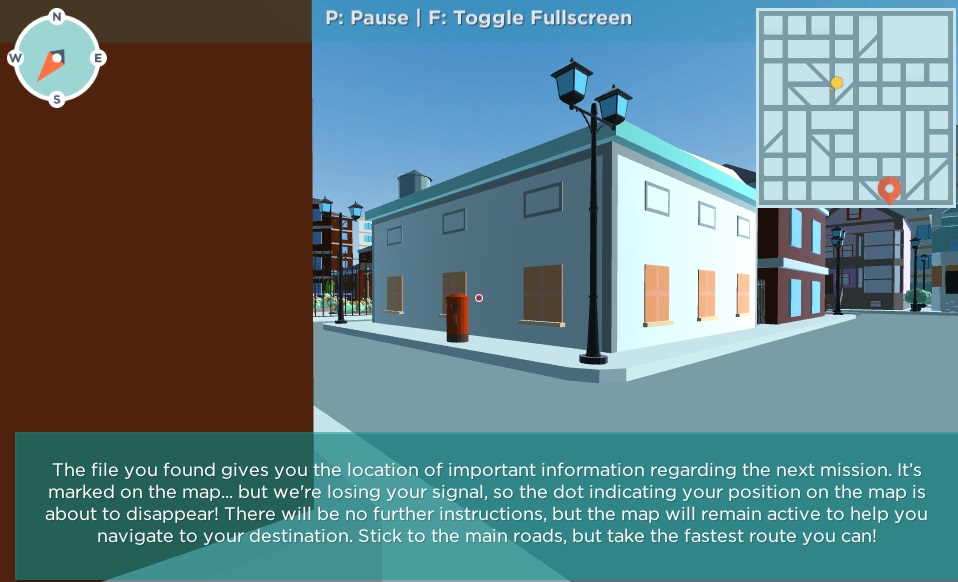
Map Reading No Memory mission 3
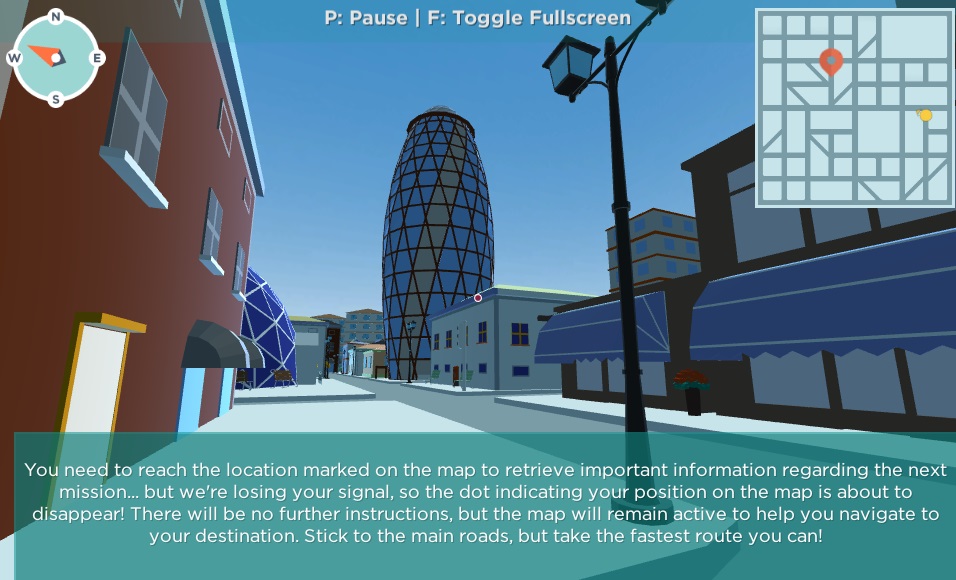
Map Reading No Memory mission 4
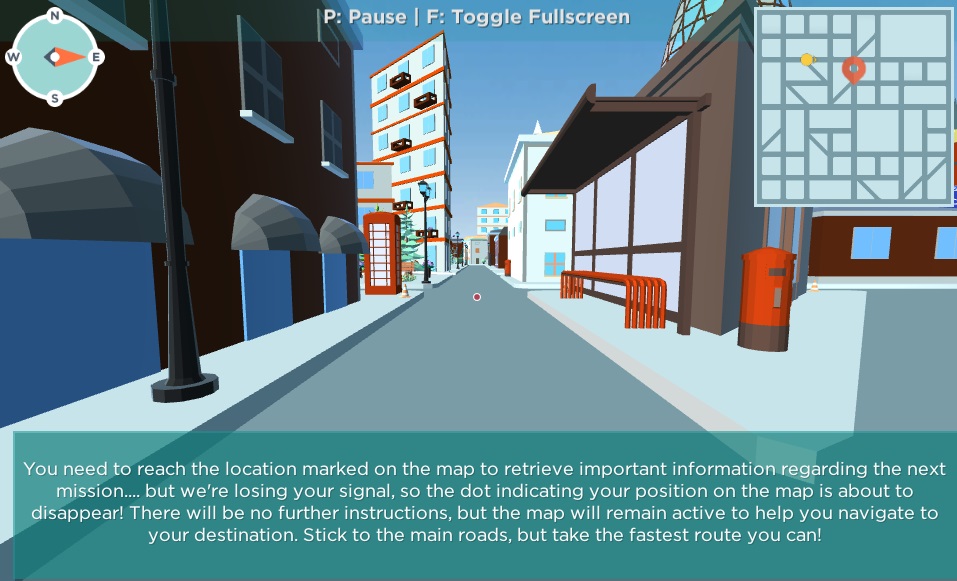
Map Reading No Memory mission 5
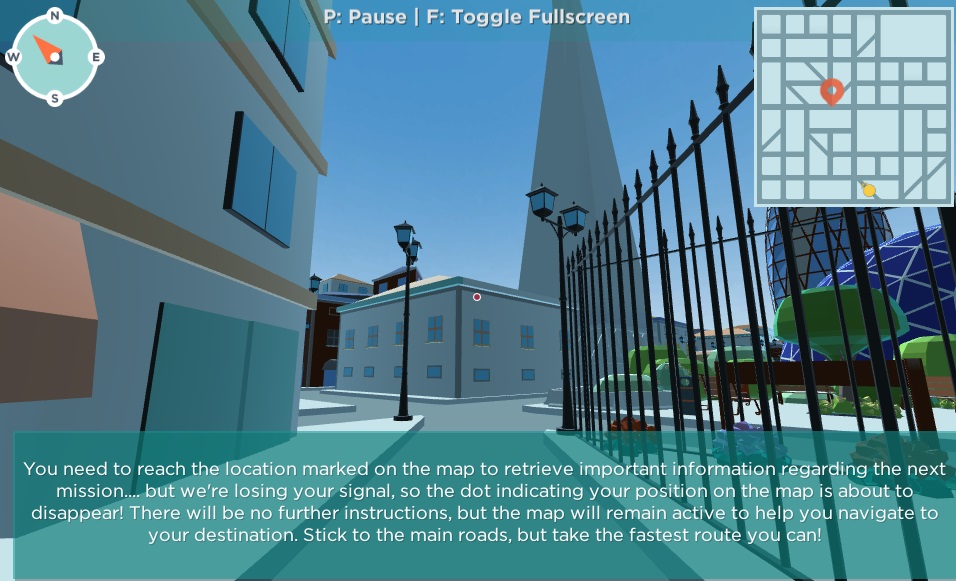
Map Reading With Memory mission 1

Map Reading With Memory mission 2
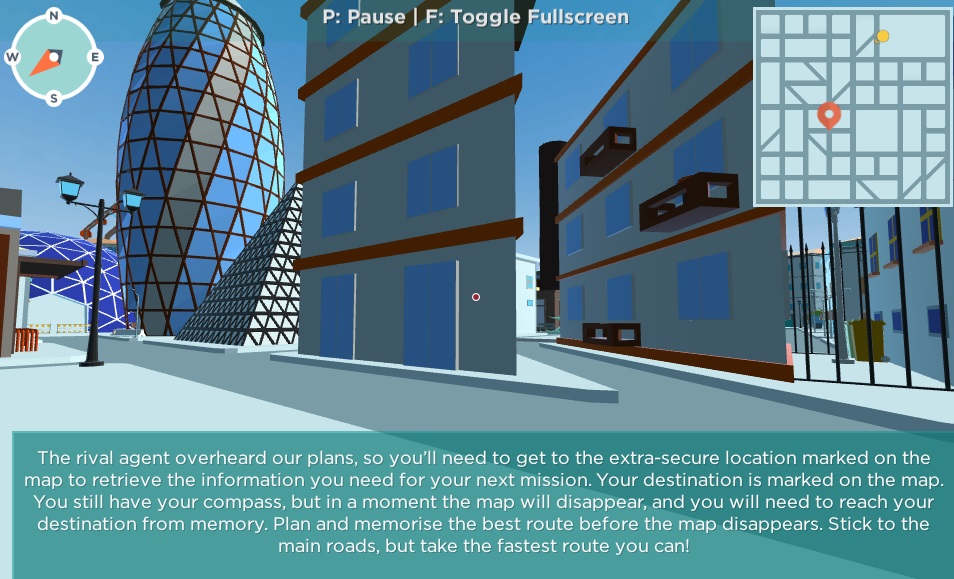
Map Reading With Memory mission 3
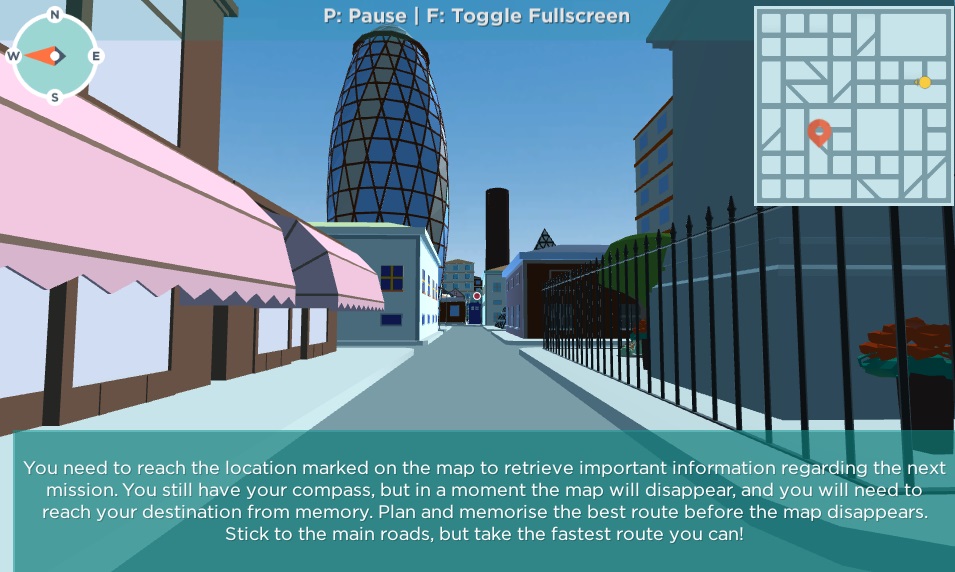
Map Reading With Memory mission 4
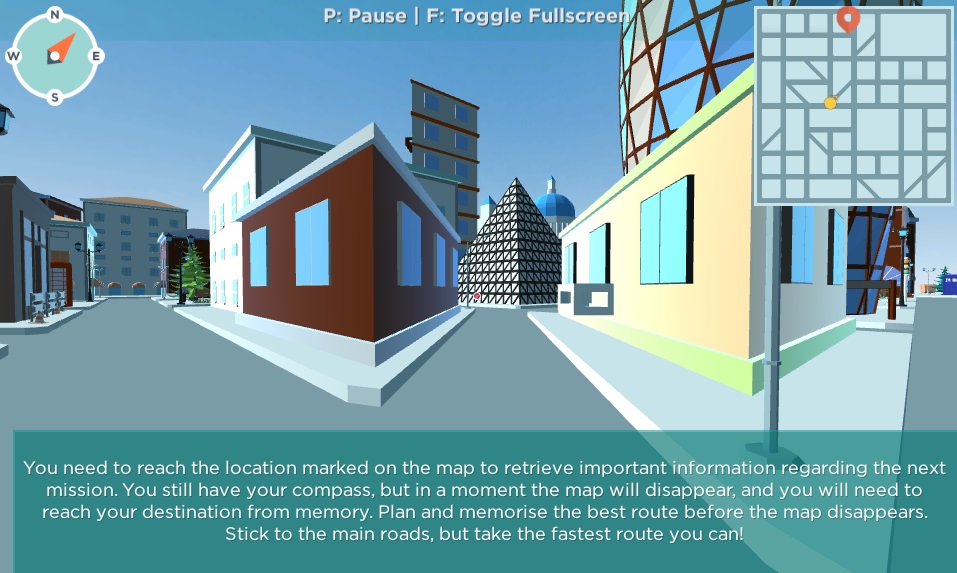
Map Reading With Memory mission 5
